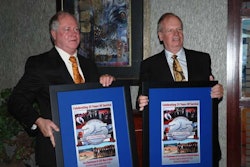A broad range of projects targeting freight transport, funded by state bond money and administered by the California Air Resources Board and air districts, has slashed emissions along trade corridors and near ports, cutting pollution from trucks, trains and ships, CARB announced Monday, Jan. 24.
More than 5,300 diesel trucks traveling the state’s busiest trade routes are being cleaned up, 19 locomotives operating in the Central Valley and Southern California are being upgraded, and clean electrical power will be available this spring for ships docking at the Port of Oakland thanks to $250 million as part of implementation of CARB’s Goods Movement Emission Reduction Program. The program is supported by $1 billion in voter-approved Proposition 1B bonds, of which $450 million already has been allocated.
“These ambitious efforts are improving our air quality as well as the quality of life for hundreds of thousands of Californians who live near major diesel pollution sources such as busy highways, ports and railyards,” says CARB Executive Officer James Goldstene. “We estimate that these projects will eliminate more than 3 million pounds of diesel soot plus 60 million pounds of smog-forming pollutants from our environment over the next few years.”
Goldstene says the program’s bond monies are leveraging substantial matching funds from private, local and federal sources – more than one match dollar for every program dollar invested – resulting in an additional $300 million above and beyond the Prop 1B bond funds to aid in overseeing pollution reduction projects through to their completion within the next few years.
To update the 5,300 trucks – including those that service the state’s busiest ports – older trucks have been replaced with new diesel models or those powered by natural gas meeting cleaner 2007 or later emissions standards. In the four targeted trade corridors – Bay Area, Central Valley, Los Angeles/Inland Empire and San Diego/Border – most equipment owners opted to replace their trucks. However, in the Bay Area, a majority of the port truck owners chose to retrofit their vehicles with diesel soot filters that trap at least 85 percent of particulate emissions.
In a shift from many previous programs, one-third of the trucks that received program funding are owned by owner-operators, and half of the funded vehicles are in fleets of 20 or fewer trucks, considered in California to be a small or medium-sized fleet.
Additional cleanup activities focusing on installing clean electric power for ships at dock will get under way as air districts start soliciting for more than $80 million in projects in early 2011. The board allocated an additional $112 million for more truck cleanup efforts, with smaller grants to be available to clean up locomotives and harbor craft such as tugboats.














